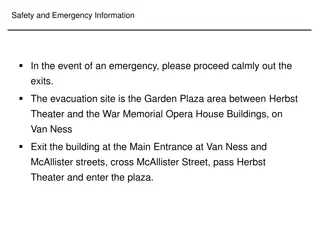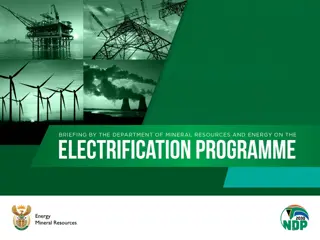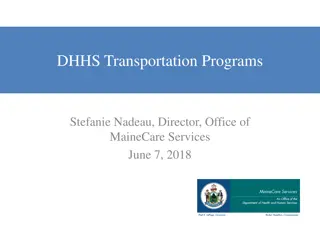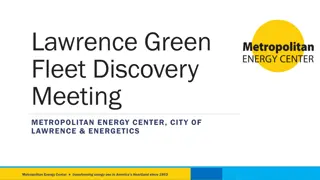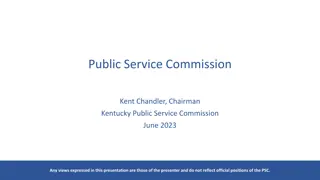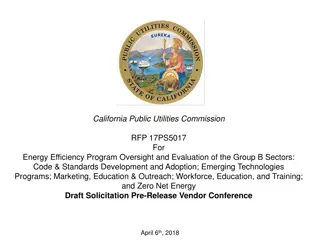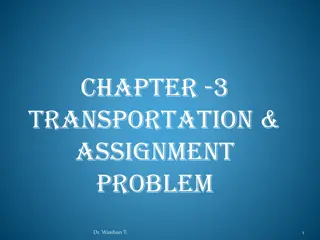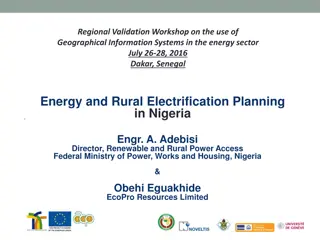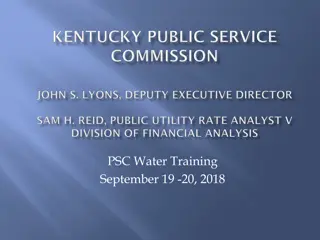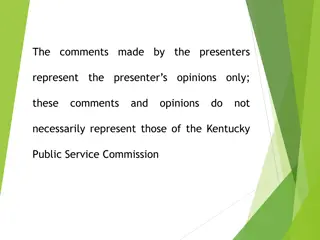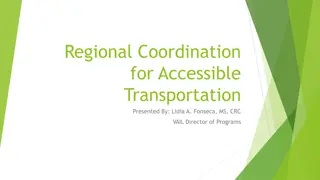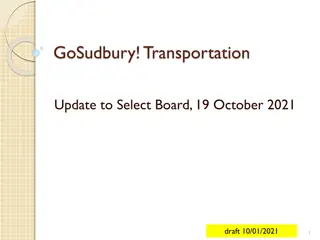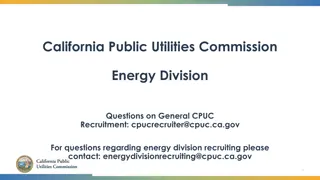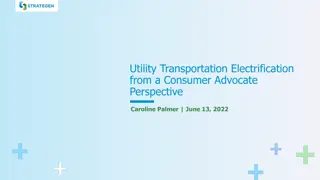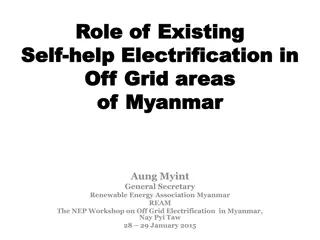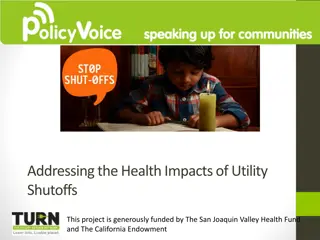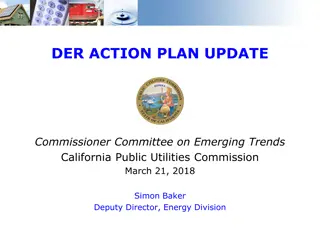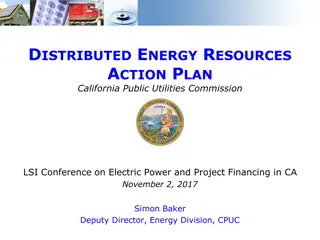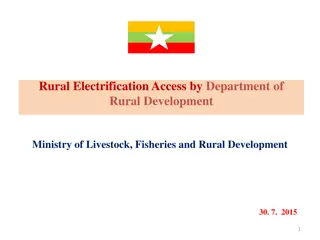California Public Utilities Commission Transportation Electrification Programs Overview
The California Public Utilities Commission (CPUC) oversees energy providers in achieving California's Transportation Electrification (TE) goals. This involves designing rates to promote electricity as a lower-cost option, ensuring clean electricity procurement, integrating electric vehicles for grid benefits, and managing infrastructure for charging stations. Various CPUC TE programs are in place to implement legislative mandates and focus on increasing access to charging infrastructure and electrifying vehicles, with significant spending authorized and pending through 2023.
Download Presentation

Please find below an Image/Link to download the presentation.
The content on the website is provided AS IS for your information and personal use only. It may not be sold, licensed, or shared on other websites without obtaining consent from the author. Download presentation by click this link. If you encounter any issues during the download, it is possible that the publisher has removed the file from their server.
E N D
Presentation Transcript
CALIFORNIA PUBLIC UTILITIES COMMISSION CALIFORNIA PUBLIC UTILITIES COMMISSION TRANSPORTATION ELECTRIFICATION ACTIVITIES TRANSPORTATION ELECTRIFICATION ACTIVITIES Transportation Electrification Programs Overview 1
The CPUC oversees the role energy providers serve in meeting The CPUC oversees the role energy providers serve in meeting CA s Transportation Transportation Electrification (TE) goals Electrification (TE) goals CA s Fuel Providers Design rates that ensure electricity is a lower-cost option than conventional fuels Provide increasingly clean electricity with higher renewable generation procurements Grid managers Ensure additional load from electric vehicles (EV) is integrated in a manner that provides grid benefits Encourage charging behavior that supports the integration of renewable energy onto the grid Infrastructure providers Manage and build out distribution and transmission systems Ensure sites are ready for customers to install charging infrastructure and provide some support for EV service equipment (EVSE) installation 2
CPUC TE programs implement legislative mandates CPUC TE programs implement legislative mandates 3
IOU TE infrastructure programs focus on increasing access to charging stations ~$1 billion in authorized IOU TE infrastructure spending through 2023 ~13,500 light-duty charge ports at workplaces and apartment buildings (SCE, PG&E, and SDG&E) Medium- and heavy-duty infrastructure programs required to electrify ~15,000 vehicles (SCE and PG&E) Public DC fast charging program to provide up to 234 new fast-charging ports (PG&E) Pilot programs designed to address identified barriers to ZEV adoption (all 6 IOUs) ~$1 billion in pending IOU TE infrastructure spending proposals under CPUC review Program to electrify between 3,000 and 6,000 MD/HD vehicles (SDG&E) Extension of SCE's light-duty program to provide another ~48,000 charge ports (SCE) Pilot programs to install light-duty infrastructure at schools and state parks and beaches (SCE, PG&E, SDG&E, and Liberty Utilities) Pilot to install infrastructure at low- and moderate income residences (PG&E) 4
Light-Duty Vehicle Infrastructure Pilot Programs test different IOU ownership models SDG&E Power Your Drive SCE Charge Ready PG&E EV Charge Network 3,040 charging stations installed at 260 sites expected by March 2019; ~$73 million in expected expenditures 1,063 charging station installed at 71 sites as of December 2018 322 charging stations installed at 23 sites as of November 30, 2018 Program Status 1,500 charging stations, with another 1,000 authorized in 2018 Scope 3,500 charging stations at 300 sites 7,500 charging stations $44M total after $22M in additional funding authorized in D.18-12-006 Budget $45M $130M Markets multifamily, workplace multifamily, workplace, public multifamily, workplace 39% of installed sites in DACs, well above the 10% minimum adopted in D.16-01-045 ~48% of projects in DACs, well above the 10% minimum adopted in D.16-01-023 15% charging stations in disadvantaged communities Disadvantaged Communities Site host. PG&E ownership allowed only in multifamily or disadvantaged community up to 35% of total sites Charger Ownership SDG&E Site host Cost to host Participant Payment at sites not in DACs Rebate Participant Payment or Rebate Rates Vehicle-grid integration rate to driver or host Time-of-use rate to host Time-of-use rate to driver or host Approved Jan 2016 (CPUC Decision 16-01-045) Approved Jan 2016 (CPUC Decision 16-01-023) Approved Dec 2016 (CPUC Decision 16-12-065) Regulatory Status
NRG Settlement funds nearing exhaustion NRG Settlement funds nearing exhaustion California entered into a settlement with NRG in 2012 to settle outstanding claims from the 2001 Energy Crisis NRG committed to spend $102.5 million on EV charging infrastructure $50.5M for DC fast charging stations (200 site minimum) $27.5M for make-ready infrastructure (6,875 port minimum) $12.5M for 10 DC fast charging plazas to serve residents of multi-unit dwellings $5M for technology R&D pilots (three pilots deployed) $4M for programs for underserved communities (two projects deployed) Extension on settlement expenditures approved November 2018 to fully exhaust funds and install additional charging infrastructure 6
SB 350 programs currently under implementation SB 350 programs currently under implementation ~$45 million in pilot programs addressing specific barriers in transportation electrification Port electrification Truck idle reduction efforts Commuter lots/ encouraging use of mass-transit hubs Urban DC fast charging plazas targeting apartment dwellers $22.5 million to install DC fast charging stations along transit corridors $579 million to install infrastructure to support medium- and heavy- duty vehicle electrification 7
IOUs participation in CARBs Low Carbon Fuel Standard IOUs participation in CARB s Low Carbon Fuel Standard The IOUs (electric and natural gas) receive LCFS credits from CARB on behalf of their customers for low carbon-intensive fuel used for transportation (CNG vehicles and EVs) Current programs: the IOUs provide customers either a bill credit or a rebate Future programs: Statewide Recent CARB regulation changes directed the establishment of a statewide point-of-purchase rebate program, funded in part by 67% of the IOUs LCFS credits IOUs the remaining 33% of the IOUs LCFS credits can fund other programs, as directed and approved by the CPUC 8
IOU TE infrastructure investments approved and proposed IOU TE infrastructure investments approved and proposed $900,000,000 $800,000,000 $700,000,000 $600,000,000 $500,000,000 $400,000,000 $300,000,000 $200,000,000 $100,000,000 $- Workplace & MUD $237,126,980 $815,472,000 Medium/Heavy Duty $593,269,500 $115,000,000 Residential $143,100,000 $4,130,000 Public Charging $34,000,000 Approved Proposed 9 Note: SDG&E has declined to implement its Residential Charging Program authorized in D.18-05-040 which represents about $137 million of the approved residential amount
Open Transportation Electrification proceedings Open Transportation Electrification proceedings Reopening of SB 350 decision (D.18-05-040) via PFM (A.17-01-020) - SB 350 program proceeding, which Cal Advocates reopened via PFM to address cost allocation SDG&E MD/HD Program (A.18-01-012) - A medium- and heavy-duty EV infrastructure program SCE Charge Ready Phase 2 (A.18-06-015) - Expansion of SCE s Charge Ready program AB 1082/1083 (A.18-07-020 et al.) - Pilot programs pursuant to 2017 legislation to install EV charging infrastructure at state beaches and parks and schools PG&E Empower EV Charge Network (A.18-07-021) - Pilot to install EV charging infrastructure at low-and moderate-income customers homes PG&E Commercial EV Rate (A.18-11-003) - A new commercial EV rate to address unique challenges of fueling EVs DRIVE OIR (R.18-12-006) 10
CPUC initiated a new rulemaking to provide clear guidance CPUC initiated a new rulemaking to provide clear guidance for future IOU TE investment programs for future IOU TE investment programs DRIVE OIR (R.18-12-006) directs the CPUC to identify a clear role for IOUs in meeting statewide TE goals To be informed in part by AB 2127 needs assessment and statewide ZEV adoption, GHG, and air quality targets Improve access to charging for all ratepayers Align investments across state and local agencies Design programs that encourage third-party investments Explore emerging issues such as micromobility, car- and ride-sharing services, and autonomous vehicles CPUC Energy Division to propose Transportation Electrification Framework that guides future IOU investments Prioritize program types needed to meet state goals Streamline and expedite application review process New utility TE applications will continue to be processed under existing regulatory authority while the new framework is under development 11
New rate designs to encourage low New rate designs to encourage low- -cost EV fueling cost EV fueling Each of the IOUs offer optional EV rates for residential customers Rates can be applied to EV-only load or a customer's whole-house load Simple TOU-based rates SCE Commercial EV rate approved in May 2018 (D.18-05-040) Energy-only volumetric rates in years 1-5 Demand charges phased back in during years 6-10 Anticipated to be available for enrollment starting March 2019 SDG&E Vehicle-Grid Integration rate for commercial customers Applies to customers participating in SDG&E s Power Your Drive light-duty vehicle infrastructure program Hourly day-ahead energy pricing Adders for grid-constrained hours system-wide and distribution-level PG&E's proposed Commerical EV rate class (A.18-11-003) Subscription-based rate with time-variant volumetric energy rates Subscription considered more consistent than demand charges 12
Initial reporting results confirm some rate design success Initial reporting results confirm some rate design success to shift charging from peak demand periods to shift charging from peak demand periods IOU Load Research Reports show residential customers enrolled in EV-TOU rates avoid on-peak hours for EV charging SCE s Charge Ready demand-response program initial results suggest commercial EV charging load can be shifted to absorb midday excess renewable generation that may otherwise be curtailed SDG&E s dynamic, hourly VGI rate suggest customers at commercial sites reduce charging during system and circuit peak hours to avoid high cost fueling SDG&E estimates more than 85% of fueling at its Power Your Drive charging stations occurs during off-peak hours Average rate for fueling as of late 2018 was $0.21/kWh compared to a system average cost of $0.24/kWh 13
Vehicle Vehicle- -Grid Integration is an interagency effort Grid Integration is an interagency effort California VGI Roadmap Currently being updated by the CEC, in collaboration with CARB, CPUC, CAISO, and GO-Biz 2017 VGI Communication Protocols Working Group Staff recommended hardware requirements to ensure infrastructure is capable of high-level communication New interagency VGI working group directed in DRIVE OIR Directed to focus on identifying strategies to realize and capture the value of VGI use cases Will consider VGI within the context of other available DER resources and use cases Plug-in Electric Vehicle Submetering Pilot Workshop scheduled for 6/24 at the CPUC to discuss the pilot and next steps for submetering 14
Energy Division TE Team Energy Division TE Team Sara Kamins Supervisor, Transportation Electrification Josh Huneycutt EV Empower PG&E Commercial Rate Audrey Neuman Light-duty EV infrastructure pilots LCFS NRG Settlement Carrie Sisto SB 350 VGI Michael Truax AB 1082/1083 Submetering 15






